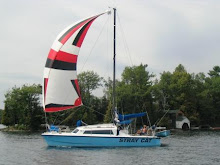









Lobsters are yummy. They also aren’t very smart. Once found, they will generally stay put until captured. Some people have suggested grabbing them by hand (not a great idea if an eel happens to also be in the same hole) and some have suggested that their legs can become entangled in a mop (but we could not get this to work). I have found that a single prong pole spear down their throat seems to work best as a means of capture.
The trick is to find them.
They must be over a certain size and at least 200 yards off shore.
You have to look under rock ledges and any hole where they might hide.
Once, and only once, we found the mother of all lobster hangouts. You have a boat limit of 6 per person, so we stopped there. Unfortunately for us, someone else followed us and cleaned the place out so we could not return.
The happy hunters and their booty are shown above. The picture of the lobster in the water was taken at Sandy Cay, an underwater park. This one, we could only capture with our camera and leave for others to enjoy.
We have also tried hunting fish. They are much easier to find, but more difficult to catch. It is easy to get close to a small fish. It is much more difficult to get close to a large fish unless it is hiding in a cave. One of the photos shows Bev feeding the fish in an underwater park. I think she might have been hoping that some might have followed us outside its boundaries.
We used a 5 foot pole spear with a single point and a folding barb to catch the lobster. It worked well. It did not work well for free swimming fish, however, as its range is too limited. You have to get within about 2 feet of the fish when you release the pole if you want it to penetrate fully. The pole spear with the single barb does not work well for fish in caves. The problem is that the spear will drive the fish back and then the tip of the spear will hit the wall of the cave before it has penetrated fully. At this point, the fish is probably mortally wounded but will escape, never to be seen again.
Our next try was a 6 foot spear with a longer elastic for more thrust and a 3 pronged spear which much less penetration for the barbs to take hold. Our hope is that it will be better.
We will also try a Hawaiian sling. This consists of a short handle with a hole into which a spear slides and an elastic to shoot it. The range of a Hawaiian sling is much greater and it should be better for open water. The spear is completely free, however, so you should not use it where you could not dive to the bottom to retrieve it.
Life is an adventure and so is fishing. We look forward to its continuation.
The trick is to find them.
They must be over a certain size and at least 200 yards off shore.
You have to look under rock ledges and any hole where they might hide.
Once, and only once, we found the mother of all lobster hangouts. You have a boat limit of 6 per person, so we stopped there. Unfortunately for us, someone else followed us and cleaned the place out so we could not return.
The happy hunters and their booty are shown above. The picture of the lobster in the water was taken at Sandy Cay, an underwater park. This one, we could only capture with our camera and leave for others to enjoy.
We have also tried hunting fish. They are much easier to find, but more difficult to catch. It is easy to get close to a small fish. It is much more difficult to get close to a large fish unless it is hiding in a cave. One of the photos shows Bev feeding the fish in an underwater park. I think she might have been hoping that some might have followed us outside its boundaries.
We used a 5 foot pole spear with a single point and a folding barb to catch the lobster. It worked well. It did not work well for free swimming fish, however, as its range is too limited. You have to get within about 2 feet of the fish when you release the pole if you want it to penetrate fully. The pole spear with the single barb does not work well for fish in caves. The problem is that the spear will drive the fish back and then the tip of the spear will hit the wall of the cave before it has penetrated fully. At this point, the fish is probably mortally wounded but will escape, never to be seen again.
Our next try was a 6 foot spear with a longer elastic for more thrust and a 3 pronged spear which much less penetration for the barbs to take hold. Our hope is that it will be better.
We will also try a Hawaiian sling. This consists of a short handle with a hole into which a spear slides and an elastic to shoot it. The range of a Hawaiian sling is much greater and it should be better for open water. The spear is completely free, however, so you should not use it where you could not dive to the bottom to retrieve it.
Life is an adventure and so is fishing. We look forward to its continuation.

No comments:
Post a Comment